~THOR~
NO! I don't mean the Norse god of thunder!
I write about motorcycles, you do know that!
This is an illustration of what I mean:
Some may wonder to themselves: "Why would she choose this picture, rather than a motorcycle that has been replicated or renovated? Simple, look at the above motorcycle, and now look at this renovated example.
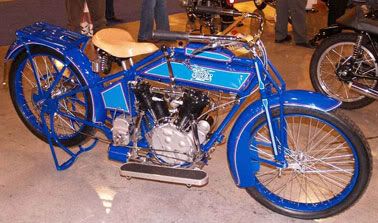
What feelings are brought out when you first look at the un-restored version of this motorbike?
For me, I am awe struck. I see how time has affected this bike. I am struck with the wanderlust and vividness of my imagination. I am struck by the mean roads this bike endured, the deep mud holes, the rutted meandering roads, made by wagon loads of people and transport items. Roads that were not designed for the motorcar or the motorcycle.
I see this un-restored version of the mighty Thor motorcycle...and I am transported back to time I have only read about, a time my grandfather would remember...if he were alive. My mom remembers the roads. She was born in 1929 and was raised in a rural community. The main roads were paved by then, but the roads leading back to the farms were still the rutted lane where plow horses and wagons, with the occasional tractor still plied the countryside.
![[Gas pump with clothesline, barn and horse-drawn wagon in background] (LOC)](http://farm3.static.flickr.com/2145/2179176818_0d8992c3f4.jpg)
As I was studying, examining, and researching the world wide web for anything "THOR", I found a website by a gentleman named Greg Walter. Mr. Walter's website is the most informitive website I have ever encountered when researching information on the classic or the antique motorcycle. I believe Mr. Walter is the DEFINITIVE authority on this motorcycle.
The Thor Motorcycle Company, was born from the Aurora Machine and Tool Company. As one might deduce from the title of the company, Aurora started as a machine shop. The doors opened for business in 1886 and their main focus was to provide forging facilities as well as machine parts for the rapidly mushrooming bicycle industry.
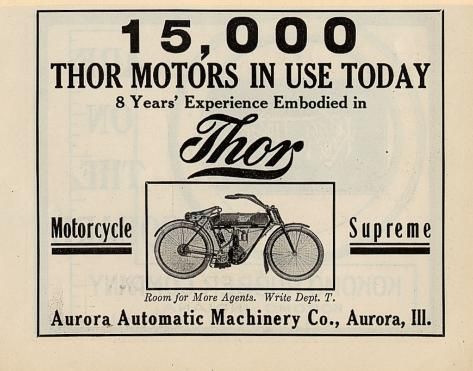
As I understand, Aurora Machine and Tool Company started out as a type of wholesale parts house for bicycle builders. According to Mr. Walter, by 1903 their parts line was considerable.
The 1903 catalog boasts "10 different rear hubs, 5 front hubs, racing hubs, spokes nipples, handlebars, special spoke washers to be used with wooden rims and a large number of patents were listed." (1)

In 1899, a guy named Oscar Hedstrom decides to build his first motorcycle. From the time he was 9 years old, Oscar was intrigued with the mechanical workings of the bicycle. As was the custom of most teenage boys of working class families, Oscar was working by the age of 16. He apprenticed at watch makers shops, until the age of 21, when he gained the rank of Journeyman. Working out of his own shop, Hedstrom had found ways to produce a better product than was being mass produced during the period. His bikes were considered a higher quality because of their lighter yet more durable construction.
Hedstrom's reputation grew. With the influx of more money, he was able to branch out and start building gas engines to power his bicycles. Back in his day, bicycle racing was a huge sport (as it is today), and the tandem rigged motorcycle was used as a pace bike for bicycle races. With the Tandem motorcycle, the front person steered while the person in back would make all the adjustments to keep the motorcycle running. From what I've read, that can be a two man job, between adjusting the valves as the engine heated up, adjusting the carb, and adjusting the cam, keeping the oil pumped up on a total loss system. Yeah that guy on the back had a stressful job!
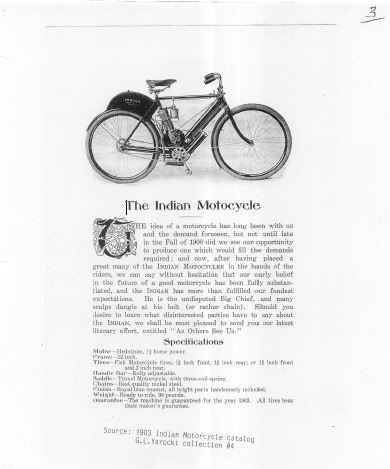
Hedstrom's machines grew in reputation. Their dependability while on the track was being noticed by racing champion George Hendee. George was so impressed with the pacers built by Hedstrom, that he asked Hedstrom to bring to Springfield Mass. a prototype of a massed production motorized bicycle. The two men knew they had something worth investing time and money in. They formed a business, that in time became: INDIAN MOTORCYCLE COMPANY.
By now, I'm sure your all asking yourself's yeah so? What's this all to do with the Thor?
Plenty...sit back while I relate to you what I've learned! It's extraordinary!
When Oscar joined forces with George in 1901, it was with Hedstrom's engine, whose design closely resembled the French engine: De Dion. The subtleties in the design change gave Hedsrtom's engines a quality that was far ahead of the engines in use at the time. It is during this time (1901) that Indian Motorcycles created three prototypes of their Indian. It is well documented that one of those prototypes made it's way to the Aurora factory to be studied by their own machinists. It is thought Aurora was chosen because of a history of excellent parts supplied to George for the building of his Silver King and Silver Queen bicycles.
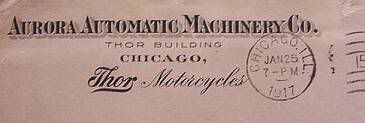
Through the study of Hedstom's engine, Aurora made several modifications to the engine. They reduced the amount of engine studs from four to three, and they increased the strength of the engine cases by adding some ribs.
Once more, according to Mr. Walter; the Aurora Company entered into a business agreement with the Indian Motorcycle Company. (This was possibly done because Hedstorm had no foundry from which to work from.) The deal was struck, Aurora would make the engines for Indian Motorcycle Company, AND as long as royalties were paid to Indian Motorcycle Company, Aurora was also licensed to sell the engine to other companies. One further stipulation was that Aurora could not build motorcycles and compete with Indian.
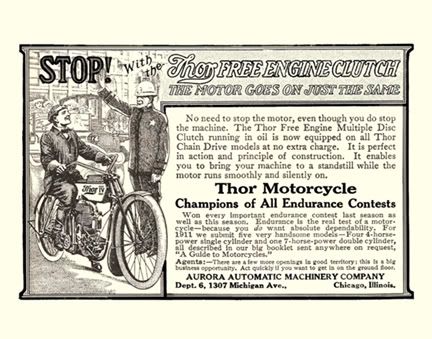
By 1902, Aurora had built all 137 engines for the output of Indian Motorcycles. Aurora no only made their engines, but in all probability most of the forgings, casting and machined parts. This again is due to the fact Indian had no foundry. There is no doubt Indian manufactured their own tins, did their own painting and braised their own frames in factory. What isn't known about Aurora, is if they sold any engines other than the 137 they made for Indian that year. It is assumed they did not, due to limited manufacturing space and abilities. (This assumption is due to something found in Indian's archives regarding Aurora's often unreliable and sporadic shipments.)
It appears Aurora could foresee huge expansion in the motorcycle industry, because by 1903 Aurora created the "THOR MOTO CYCLE AND BICYCLE COMPANY". Mr. Walter states they produced a catalog that listed every part needed to produce a motorcycle. In other words, they were keeping true to the agreement, to the letter. They were not producing motorcycles, but they were producing all the part required to put a motorcycle together. Yes ladies and gents, Aurora was now in the buisness of selling motorcycle building kits. The KIT MOTORCYCLE WAS BORN! (It should be noted, no frame was offered for sale with this kit, and a picture of the assembled bike was shown beside this cleverly worded enticement "MOTORCYCLE ASSEMBLED WITH THOR COMPONENTS"
Apparently other machining companies took note of Aurora's idea and soon after produced their own kits, whose designs were almost exact to the 1902 Indian and the 1903 Thor. Mr. Walters calls these upstart companies...CLONES. I like that...clones...

Mr. Walters is very informative regarding the differences between a Thor, a Thor clone and an Indian. He says "the forgings may all be the same, but the frames were all built using different jigs and possibly different dimensions." (2) He says it's damn near impossible to get it all sorted out these days because there are only about 12 1902 surviving Indians, and most of them have some wrong components on them.
Surviving Thors from 1902 to 1905 are considered highly suspect regarding their intact components. There just aren't enough survivors to cement conclusions. Part of the problem is that some clones have been restored to look like Thors, and some Thors have been restored to appear to be Indians! The problem is, over the years, the parts were interchangeable, and without better documentation of what parts were used on the early models, it's impossible to say it is restored 100%.
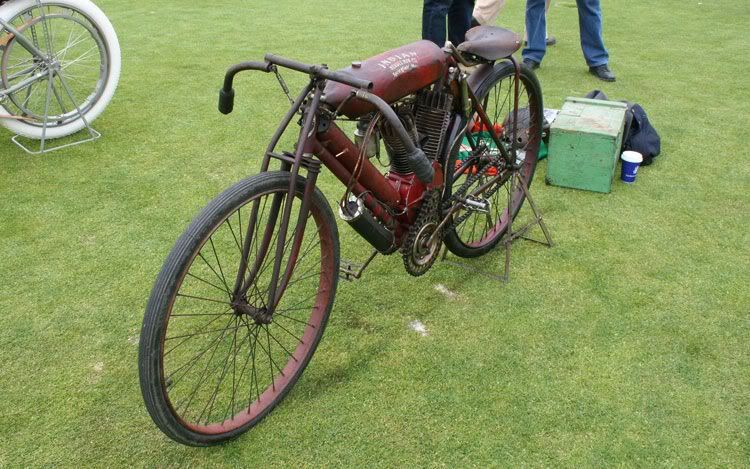
Some notable differences between the Thor and the Indian was perhaps the "skip roller chain" on the Thor while the Indian used the "block" chain. Other differences were the right sided spark advance. I'm told the Thor had a type of rack and gear array at the headstock while Indian used a link that came out of the handlebar. (A far safer arrangement I would suspect.) I've read that the Thor engine also had a kill switch on the engine case. It was triggered only when the spark was completely retarded. A kill switch of this nature was not on the Indian.
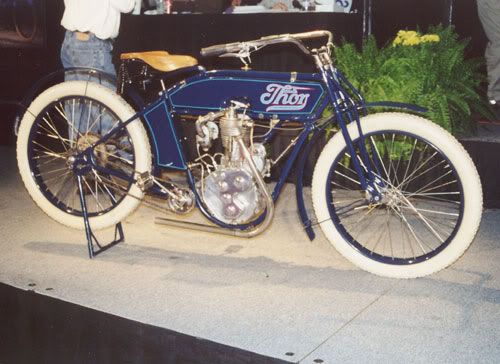
image from therocketman.com
There are records at Indian Motor Company stating they formed their own in house foundry by 1906. It is a fact, that by 1908, Thor opened their own dealerships, advertising COMPLETE motorcycles. It can be assumed this was the end of any contractual ties to Indian. Between 1903 and 1905, there were no changes to the engine built by Aurora, but a surviving parts book from 1908 indicates for the years 1906 and 1907 there was a different model on line up for sale. There were many design changes, but by 1908 a new engine replaced the 1906 and '07. It was marketed as "MODEL 7" and was in use until early in the year of 1909.

Image from Picocool.com
The new Thor dealerships offered the consumer a choice of either the battery or the magneto ignition. The buyer could also choose between belt or chain drive. Thor also offered a twin, that was designed with one cylinder that stood straight up (rear) while the front was angled slightly forward (think of a Ducati). It is said this design worked almost flawlessly...unlike the automatic intake V-Twin design used by both Harley and Indian.
The Thor changed significantly from 1911 to 1918. Each new year saw more changes, advances in engineering design. The first change in 1911 saw the inclusion of the "free engine clutch". It was also the end of the belt drive...except for the single cylinder models. If you've ever seen the belt drives for this era, you could only assume the reason for this is due to more torque is equal to more slippage, we all know that sucks!
Walter also relates of a change to the intake valves of this 1911 model. He says there was a pull rod used to open the intake valve. Whoooaa, how in the heck did the rider have all the hands available to open this, close that, make carb adjustments, pump oil here or there...good lord! I laugh at people who complain they can't seem to get the clutch and shifting combo down...so they opt for the automatic tranny...I guess these people would still be riding the bicycle if they were around in the early 20the century. Another rather dangerous change was in how the timeing was changed. Rather than advance and retard the timeing plate, it was the job of the motorcyclist to "move the magneto idler gear"! OH MY GOD>>>>>>That had to be very complicated, how did you do that and manage to stay on the road at the same time? Sheesh! They tossed that idea into the trash heap by 1912.
1912 saw the addition of rocker arms added to the engines of both the single and the twin. Thor also changed the V degree to 50 degrees. They also offered a 2 speed tranny that mounted that mounted to the side of the rear hub. This tranny was offered on Thor's models until 1914, and other motorcycle companies used this design, including Henderson on their Henderson Four model.
The next major change in Thor wasn't until 1914. They began to offer the 1000cc and 1200cc engine. They also began to offer the Shebler Carburetor for their bikes until this time the only carb available on the Thor was Thor's own designed updraft carb. Mr. Walters further states that as with most motorcycle companies in 1914, Thor also added foot boards! That had to make things a bit more stable and comfortable...in my mind anyway. One of the major problems (in my point of view) was that Thor continued to use the pedal crank rear brake. Uh...we are talking about engines with 1000 cc or more here....I wouldn't like trusting my stopping power to a pedal crank...would you? Oh they do say that an additional ratcheting device was added to aid in leverage for this almost non existent braking system.
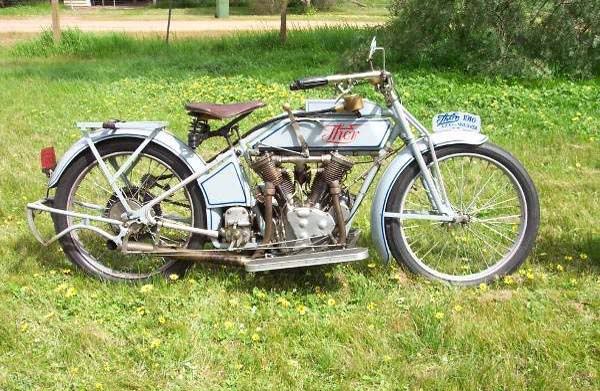
photo from gvmvdc.org.au/images/clubphotos/images/1916%20Thor.jpg
By 1915, something was amiss in the design and foresight of the Thor Motor Company. I've thought about what was happening here, the languishing of the design department, and I've come to the conclusion that it is because Thor didn't depend heavily on the race element for it's forward momentum, unlike Harley, Indian and Excelsior. These companies got into racing. With racing comes an R&D section. There just was no such research and development section urging Thor to compete or to simply keep up with the Jone's. The best Thor could manage in 1915 was to add electric lights to the bike, powered by a splitdorf mag dyno. One other design change was in the two speed tranny. The best they could do was offer a cast iron two speed that sat aside from the rear hub. All the other major motorcycle companies were offering three speed. So while the "new" tranny was of a more durable design, it's weight left much to be desired.
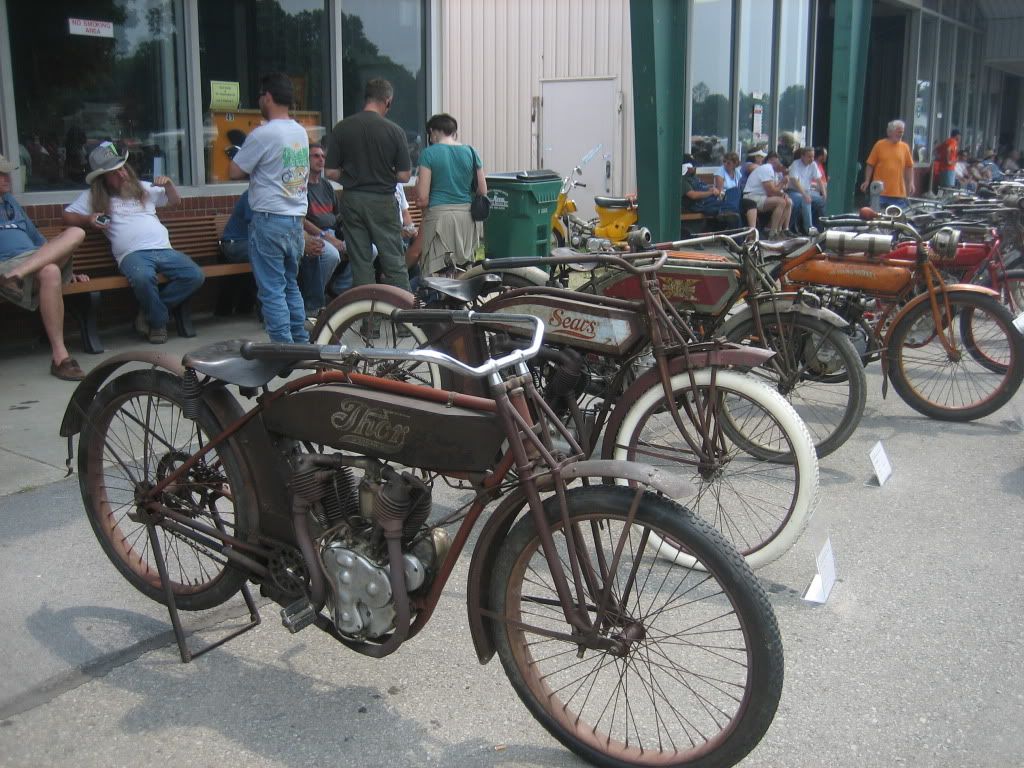
photo from the74shop.com
Ahhhh, 1916. The last year Thor saw any real changes. At last the company built a three speed transmission for the bikes. That was it. Nothing new, nothing innovative, nothing of any further significance came from the Thor factory. Thor's parent company, Aurora Independent Machine and Tool was busy making other useful items, like the combination clothes washer/dishwasher. And while the last of Thor's engines were probably built in 1916, (no clear record can be found of later assembly of engines,) they most certainly continued to manufacture the Thor motorcycle through the year 1918...possibly as late as 1920...
Thor continued to produce power tools under the name THOR until the late 1950's...then declined into obscurity forever more.
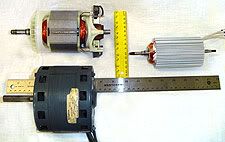
from ZPEnergy.com

What feelings are brought out when you first look at the un-restored version of this motorbike?
For me, I am awe struck. I see how time has affected this bike. I am struck with the wanderlust and vividness of my imagination. I am struck by the mean roads this bike endured, the deep mud holes, the rutted meandering roads, made by wagon loads of people and transport items. Roads that were not designed for the motorcar or the motorcycle.
I see this un-restored version of the mighty Thor motorcycle...and I am transported back to time I have only read about, a time my grandfather would remember...if he were alive. My mom remembers the roads. She was born in 1929 and was raised in a rural community. The main roads were paved by then, but the roads leading back to the farms were still the rutted lane where plow horses and wagons, with the occasional tractor still plied the countryside.
![[Gas pump with clothesline, barn and horse-drawn wagon in background] (LOC)](http://farm3.static.flickr.com/2145/2179176818_0d8992c3f4.jpg)
As I was studying, examining, and researching the world wide web for anything "THOR", I found a website by a gentleman named Greg Walter. Mr. Walter's website is the most informitive website I have ever encountered when researching information on the classic or the antique motorcycle. I believe Mr. Walter is the DEFINITIVE authority on this motorcycle.
The Thor Motorcycle Company, was born from the Aurora Machine and Tool Company. As one might deduce from the title of the company, Aurora started as a machine shop. The doors opened for business in 1886 and their main focus was to provide forging facilities as well as machine parts for the rapidly mushrooming bicycle industry.

As I understand, Aurora Machine and Tool Company started out as a type of wholesale parts house for bicycle builders. According to Mr. Walter, by 1903 their parts line was considerable.
The 1903 catalog boasts "10 different rear hubs, 5 front hubs, racing hubs, spokes nipples, handlebars, special spoke washers to be used with wooden rims and a large number of patents were listed." (1)

In 1899, a guy named Oscar Hedstrom decides to build his first motorcycle. From the time he was 9 years old, Oscar was intrigued with the mechanical workings of the bicycle. As was the custom of most teenage boys of working class families, Oscar was working by the age of 16. He apprenticed at watch makers shops, until the age of 21, when he gained the rank of Journeyman. Working out of his own shop, Hedstrom had found ways to produce a better product than was being mass produced during the period. His bikes were considered a higher quality because of their lighter yet more durable construction.
Hedstrom's reputation grew. With the influx of more money, he was able to branch out and start building gas engines to power his bicycles. Back in his day, bicycle racing was a huge sport (as it is today), and the tandem rigged motorcycle was used as a pace bike for bicycle races. With the Tandem motorcycle, the front person steered while the person in back would make all the adjustments to keep the motorcycle running. From what I've read, that can be a two man job, between adjusting the valves as the engine heated up, adjusting the carb, and adjusting the cam, keeping the oil pumped up on a total loss system. Yeah that guy on the back had a stressful job!

Hedstrom's machines grew in reputation. Their dependability while on the track was being noticed by racing champion George Hendee. George was so impressed with the pacers built by Hedstrom, that he asked Hedstrom to bring to Springfield Mass. a prototype of a massed production motorized bicycle. The two men knew they had something worth investing time and money in. They formed a business, that in time became: INDIAN MOTORCYCLE COMPANY.
By now, I'm sure your all asking yourself's yeah so? What's this all to do with the Thor?
Plenty...sit back while I relate to you what I've learned! It's extraordinary!
When Oscar joined forces with George in 1901, it was with Hedstrom's engine, whose design closely resembled the French engine: De Dion. The subtleties in the design change gave Hedsrtom's engines a quality that was far ahead of the engines in use at the time. It is during this time (1901) that Indian Motorcycles created three prototypes of their Indian. It is well documented that one of those prototypes made it's way to the Aurora factory to be studied by their own machinists. It is thought Aurora was chosen because of a history of excellent parts supplied to George for the building of his Silver King and Silver Queen bicycles.

Through the study of Hedstom's engine, Aurora made several modifications to the engine. They reduced the amount of engine studs from four to three, and they increased the strength of the engine cases by adding some ribs.
Once more, according to Mr. Walter; the Aurora Company entered into a business agreement with the Indian Motorcycle Company. (This was possibly done because Hedstorm had no foundry from which to work from.) The deal was struck, Aurora would make the engines for Indian Motorcycle Company, AND as long as royalties were paid to Indian Motorcycle Company, Aurora was also licensed to sell the engine to other companies. One further stipulation was that Aurora could not build motorcycles and compete with Indian.

By 1902, Aurora had built all 137 engines for the output of Indian Motorcycles. Aurora no only made their engines, but in all probability most of the forgings, casting and machined parts. This again is due to the fact Indian had no foundry. There is no doubt Indian manufactured their own tins, did their own painting and braised their own frames in factory. What isn't known about Aurora, is if they sold any engines other than the 137 they made for Indian that year. It is assumed they did not, due to limited manufacturing space and abilities. (This assumption is due to something found in Indian's archives regarding Aurora's often unreliable and sporadic shipments.)
It appears Aurora could foresee huge expansion in the motorcycle industry, because by 1903 Aurora created the "THOR MOTO CYCLE AND BICYCLE COMPANY". Mr. Walter states they produced a catalog that listed every part needed to produce a motorcycle. In other words, they were keeping true to the agreement, to the letter. They were not producing motorcycles, but they were producing all the part required to put a motorcycle together. Yes ladies and gents, Aurora was now in the buisness of selling motorcycle building kits. The KIT MOTORCYCLE WAS BORN! (It should be noted, no frame was offered for sale with this kit, and a picture of the assembled bike was shown beside this cleverly worded enticement "MOTORCYCLE ASSEMBLED WITH THOR COMPONENTS"
Apparently other machining companies took note of Aurora's idea and soon after produced their own kits, whose designs were almost exact to the 1902 Indian and the 1903 Thor. Mr. Walters calls these upstart companies...CLONES. I like that...clones...

Mr. Walters is very informative regarding the differences between a Thor, a Thor clone and an Indian. He says "the forgings may all be the same, but the frames were all built using different jigs and possibly different dimensions." (2) He says it's damn near impossible to get it all sorted out these days because there are only about 12 1902 surviving Indians, and most of them have some wrong components on them.
Surviving Thors from 1902 to 1905 are considered highly suspect regarding their intact components. There just aren't enough survivors to cement conclusions. Part of the problem is that some clones have been restored to look like Thors, and some Thors have been restored to appear to be Indians! The problem is, over the years, the parts were interchangeable, and without better documentation of what parts were used on the early models, it's impossible to say it is restored 100%.

Some notable differences between the Thor and the Indian was perhaps the "skip roller chain" on the Thor while the Indian used the "block" chain. Other differences were the right sided spark advance. I'm told the Thor had a type of rack and gear array at the headstock while Indian used a link that came out of the handlebar. (A far safer arrangement I would suspect.) I've read that the Thor engine also had a kill switch on the engine case. It was triggered only when the spark was completely retarded. A kill switch of this nature was not on the Indian.

image from therocketman.com
There are records at Indian Motor Company stating they formed their own in house foundry by 1906. It is a fact, that by 1908, Thor opened their own dealerships, advertising COMPLETE motorcycles. It can be assumed this was the end of any contractual ties to Indian. Between 1903 and 1905, there were no changes to the engine built by Aurora, but a surviving parts book from 1908 indicates for the years 1906 and 1907 there was a different model on line up for sale. There were many design changes, but by 1908 a new engine replaced the 1906 and '07. It was marketed as "MODEL 7" and was in use until early in the year of 1909.

Image from Picocool.com
The new Thor dealerships offered the consumer a choice of either the battery or the magneto ignition. The buyer could also choose between belt or chain drive. Thor also offered a twin, that was designed with one cylinder that stood straight up (rear) while the front was angled slightly forward (think of a Ducati). It is said this design worked almost flawlessly...unlike the automatic intake V-Twin design used by both Harley and Indian.
The Thor changed significantly from 1911 to 1918. Each new year saw more changes, advances in engineering design. The first change in 1911 saw the inclusion of the "free engine clutch". It was also the end of the belt drive...except for the single cylinder models. If you've ever seen the belt drives for this era, you could only assume the reason for this is due to more torque is equal to more slippage, we all know that sucks!
Walter also relates of a change to the intake valves of this 1911 model. He says there was a pull rod used to open the intake valve. Whoooaa, how in the heck did the rider have all the hands available to open this, close that, make carb adjustments, pump oil here or there...good lord! I laugh at people who complain they can't seem to get the clutch and shifting combo down...so they opt for the automatic tranny...I guess these people would still be riding the bicycle if they were around in the early 20the century. Another rather dangerous change was in how the timeing was changed. Rather than advance and retard the timeing plate, it was the job of the motorcyclist to "move the magneto idler gear"! OH MY GOD>>>>>>That had to be very complicated, how did you do that and manage to stay on the road at the same time? Sheesh! They tossed that idea into the trash heap by 1912.
1912 saw the addition of rocker arms added to the engines of both the single and the twin. Thor also changed the V degree to 50 degrees. They also offered a 2 speed tranny that mounted that mounted to the side of the rear hub. This tranny was offered on Thor's models until 1914, and other motorcycle companies used this design, including Henderson on their Henderson Four model.
The next major change in Thor wasn't until 1914. They began to offer the 1000cc and 1200cc engine. They also began to offer the Shebler Carburetor for their bikes until this time the only carb available on the Thor was Thor's own designed updraft carb. Mr. Walters further states that as with most motorcycle companies in 1914, Thor also added foot boards! That had to make things a bit more stable and comfortable...in my mind anyway. One of the major problems (in my point of view) was that Thor continued to use the pedal crank rear brake. Uh...we are talking about engines with 1000 cc or more here....I wouldn't like trusting my stopping power to a pedal crank...would you? Oh they do say that an additional ratcheting device was added to aid in leverage for this almost non existent braking system.

photo from gvmvdc.org.au/images/clubphotos/images/1916%20Thor.jpg
By 1915, something was amiss in the design and foresight of the Thor Motor Company. I've thought about what was happening here, the languishing of the design department, and I've come to the conclusion that it is because Thor didn't depend heavily on the race element for it's forward momentum, unlike Harley, Indian and Excelsior. These companies got into racing. With racing comes an R&D section. There just was no such research and development section urging Thor to compete or to simply keep up with the Jone's. The best Thor could manage in 1915 was to add electric lights to the bike, powered by a splitdorf mag dyno. One other design change was in the two speed tranny. The best they could do was offer a cast iron two speed that sat aside from the rear hub. All the other major motorcycle companies were offering three speed. So while the "new" tranny was of a more durable design, it's weight left much to be desired.

photo from the74shop.com
Ahhhh, 1916. The last year Thor saw any real changes. At last the company built a three speed transmission for the bikes. That was it. Nothing new, nothing innovative, nothing of any further significance came from the Thor factory. Thor's parent company, Aurora Independent Machine and Tool was busy making other useful items, like the combination clothes washer/dishwasher. And while the last of Thor's engines were probably built in 1916, (no clear record can be found of later assembly of engines,) they most certainly continued to manufacture the Thor motorcycle through the year 1918...possibly as late as 1920...
Thor continued to produce power tools under the name THOR until the late 1950's...then declined into obscurity forever more.

from ZPEnergy.com

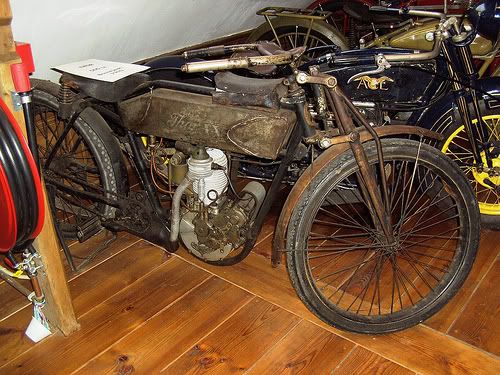








0 comments:
Post a Comment